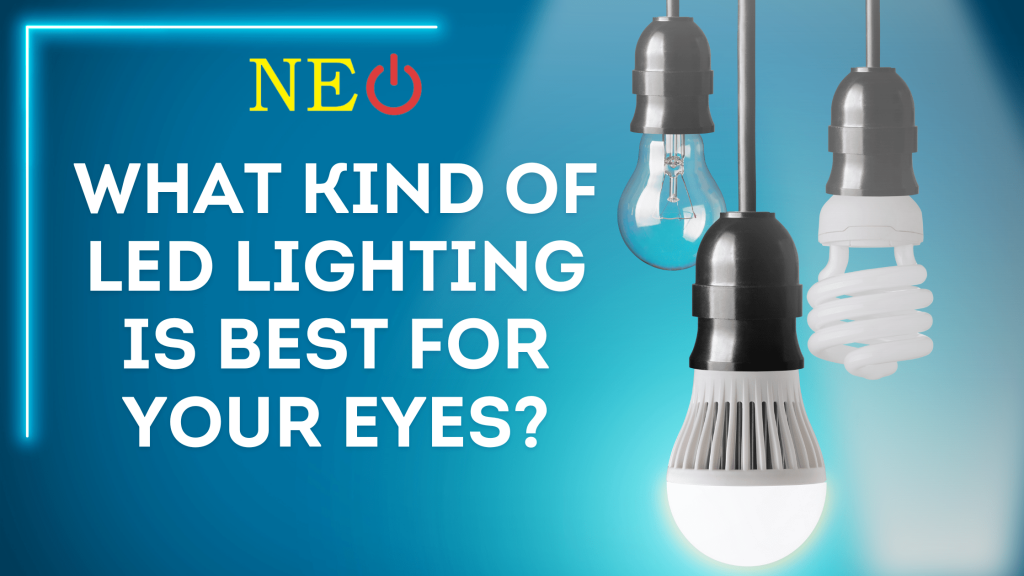Modern aesthetics and energy efficiency have led to the widespread use of LED lights in our daily life. These lights have several advantages for both homes and offices, such as long lifespan, low energy consumption, and a variety of color temperatures. But worries about artificial lighting's effects on our eyes have gained traction as we depend on it more and more. It begs the question: What kind of LED lights are safe for eyes?
Recognising the Features of LED Lighting
Prior to getting too technical, it's important to comprehend a few basic LED light characteristics:
Color Temperature: Kelvin (K) is the unit of measurement for color temperature, which goes from warm (yellow/red) light to cold (blue/white). Generally speaking, chilly light is over 5000K, neutral light is between 3000K and 5000K, and warm light is below 3000K.
Blue Light Emission: LED lights, particularly those with greater color temperatures, release blue light into the environment. Overexposure to blue light can interfere with circadian rhythms, lead to digital eye strain, and perhaps lower the quality of sleep.
Flicker: Some LEDs flicker so subtly that they might give sensitive people headaches and eye strain.
Selecting the Proper LED Lighting
In order to reduce glare and increase comfort, take into consideration the following kinds of LED lights:
LEDs in Warm White (2700K - 3000K)
The color temperature of warm white LEDs is more similar to that of incandescent lamps. Their light is pleasant on the eyes, with a delicate, yellowish hue. This kind of lighting is perfect for spaces like living rooms and bedrooms where unwinding is the main priority. Warm white LEDs can lessen eye strain and assist preserve sleep patterns by limiting exposure to blue light.
LEDs in neutral white (3500K–4500K)
Warm and cool light are balanced by neutral white LEDs. They work well for general illumination applications in places like offices and kitchens. It is easier on the eyes to read and use a computer throughout extended periods of time when the color temperature is this bright, without being too harsh.
Complete-Spectrum LEDs
Full-spectrum LEDs encompass the whole visible light spectrum, just like sunlight does. These lights are great for settings where accurate color representation is crucial, such workspaces and art studios, because they lessen the chance of eye strain and offer superior color rendering. They also support the preservation of a regular circadian rhythm, which is advantageous for the general health of the eyes.
Superior Grade Dimmable LEDs
You may greatly lessen eye strain by adjusting the brightness of dimmable LEDs to suit your needs. Select premium dimmable LEDs for reduced flicker and seamless transitions. You can have bright light when needed and softer, more calming light at other times thanks to this adaptability.
Qualities to Consider
The following aspects should be taken into account while choosing LED lights for eye comfort:
Minimal Flicker Rate: Seek out LEDs that claim to have little to no flicker. Even subtle flickering over time might cause headaches and eye strain.
High CRI (Color Rendering Index): When a light source has a CRI of 90 or higher, it renders colors accurately. By creating more natural lighting, this can lessen eye strain.
Decreased Blue Light Emission: Opt for LEDs made expressly to cut down on blue light emissions. Certain LEDs have coatings or filters integrated into them to reduce blue light, which makes them less harsh on the eyes.
Useful Advice about LED Lighting
Utilize Task Lighting: To offer focused illumination, utilize task lighting, such as desk lights, rather than relying exclusively on overhead lighting. This lessens glare and eliminates the need for high-intensity overhead lighting.
Modify Screen Settings: In addition to using eye-friendly LED lighting, those who spend a lot of time in front of screens may find that by modifying the display settings, they are exposed to less blue light.
Frequent Intervals: Adhere to the 20-20-20 rule, which states that you should glance at something 20 feet away for 20 seconds every 20 minutes. This lessens the pressure that extended exposure to artificial light causes on the eyes.
Conclusion,
The comfort and health of your eyes can be greatly impacted by selecting the correct LED lighting. Full-spectrum LEDs, premium dimmable LEDs, and warm and neutral white LEDs are all great choices to take into account. When choosing your lights, take into account characteristics like flicker rate, CRI, and blue light emission. You can design a cozy and visually pleasing space in your house or place of business by combining the appropriate LED lighting with useful usage advice.
Ultimately, flexibility and moderation are the keys to lighting that is aesthetically pleasing. LED lighting may effectively light your area while maintaining the comfort and health of your eyes if you make the proper decisions.









